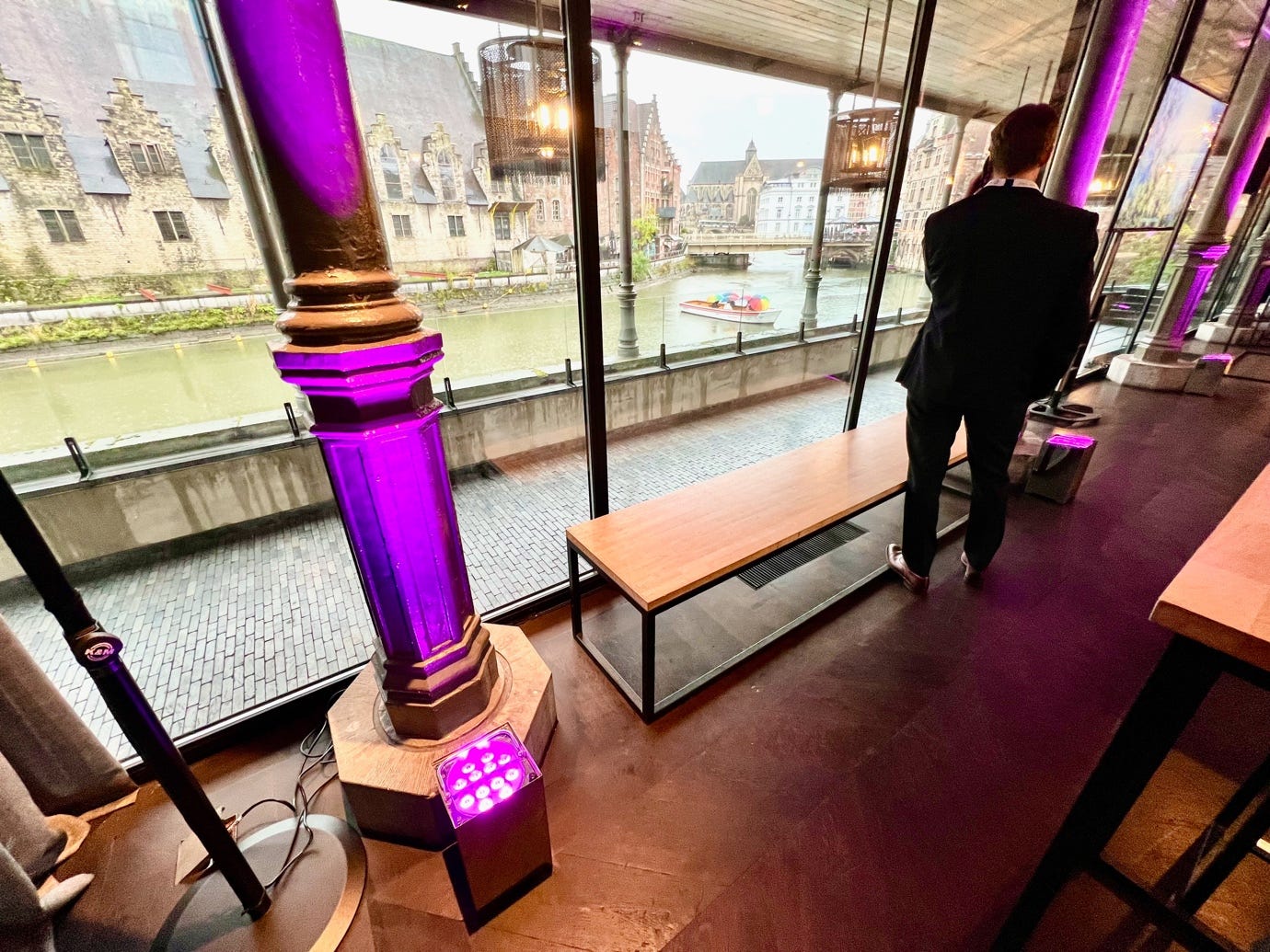Regenerative Soy: Holy Grail Or Market Imperative?
Can the soy sector create the market dynamics the regenerative transition demands?
Normally, I don’t give much brain space to the Holy Grail. But the mythical golden cup shimmered into my brain earlier this week in a rainswept Ghent. Perhaps it was because I was keynoting a roundtable event, hosted in the medieval Belgian city? (An event hosted by the Round Table for Responsible Soy, aka RTRS.) Or, again, perhaps it was because I had spent the night in the Monasterium Poortackere, one-time home of Beguine lay nuns—some of whom were hounded as heretics and even witches?
Alternatively, it may have been because of the looming presence of Gravensteen, the medieval stronghold of the mighty Counts of Flanders—looming darkly just across the road from the Old Fish Mine (Oude Vismijn), where our event was held?
Whatever the spur, the long-ago knightly quest for the Grail (which was taking off around the time the castle was built) came to mind as I listened to some of the world’s most powerful agricultural companies discussing their plans for regenerative farming—and for regenerative soy in particular.
Mining fish
The venue itself was impressive, a powerful reminder of how markets have evolved over time. That said, the “Fish Mine” tag was an uncomfortable reminder of how we have so often quarried natural resources that came within our reach, including the world’s soils.
So, were we hearing a regenerative form of greenwashing or, just maybe, the early stirrings of tomorrow’s very different market dynamics? I concluded that there seemed to be elements of both—though it was striking how often terms like “system change” and “market transformation” were used by speakers.
At times the Round Table’s 2024 international conference, entitled ‘Towards a Regenerative Transition,’ had me buzzing. Indeed, no other event I have attended since I began this ‘Rewilding Markets’ series has so perfectly captured the trajectory—the quest, perhaps—I embarked upon in the wake of the launch of my book Tickling Sharks.
The central question: how do we drive market transformations in pursuit of regeneration and ultimate sustainability?
Markets as conversations
Because the proceedings were subject to the Chatham House Rule, I am somewhat constrained as to who I can quote and how. Intriguingly, though, one early speaker did note that the history of the Old Fish Mine as a marketplace now extends back some 350 years. And such markets, he observed, have long played a crucial role as places for exchange, dialogue and learning.
That spirit informed much of what I heard. Not so surprising, given that the RTRS was founded in 2006 in Zürich, Switzerland, to provide a global reference point for the responsible production of soy. From “farm to fork” as they like to say, "generating dialogue, solutions, and positive impact in terms of both climate change and biodiversity.”
As the RTRS puts it, “By meeting the highest sustainability standards and focusing on protecting forests, biodiversity, soil health, and human health, we can create a future where both communities and businesses will prosper worldwide.”
In addition to the potential for trade wars in the wake of the recent U.S. elections, the sector sees several dark clouds looming. One is the pressure to curb deforestation. The soy industry is squarely in the sights of a growing number of civil society actors. Indeed, one panellist, from an activist NGO, argued that the current surge of regulation reflects the historic failure of the soy market to tackle key issues in time and at scale.
Anyone wanting an overview might start this World Resources Institute study launched earlier this year. It sets in context the soy contribution to deforestation. Cattle, it concludes, account for more deforestation than all other factors that WRI covers. WRI concludes that:
Globally. soy farms occupy 8.2 Mha of land deforested between 2001 and 2015. Almost all (97 percent) of this deforestation occurred in South America, with 61 percent in Brazil, 21 percent in Argentina, 9 percent in Bolivia, and 5 percent in Paraguay. The Brazilian state of Mato Grosso had by far the most forest replacement for soy, accounting for over one-third of the total. Within Brazil, 48 percent of forest area replaced by soy occurred in the Amazon, with an additional 45 percent in the Cerrado.
Still, matters have improved somewhat in recent years, as WRI notes:
The drop in forest area replaced by soy during the early 2000s coincides with Brazil’s federal plan to reduce deforestation rates in the Amazon (established in 2004), a dip in the profitability of soybeans (2005–7), and the industry-led “soy moratorium” on soy cultivated on recently deforested land in the Brazilian Amazon (implemented in 2006).18 Paraguay and Argentina also enacted laws to reduce deforestation from agricultural expansion in 2004 and 2007, respectively.
Pushback against Soy Moratorium
A particularly challenging issue hanging over the RTRS event was the increasingly effective pushback against the Soy Moratorium in the Brazilian state of Mato Gross, itself represented on one of the first day’s panels. As AP News reported:
A historic agreement that’s helped curb deforestation in Brazil’s Amazon for nearly two decades suffered a major blow after Mato Grosso, the country´s largest soybean-producing state, passed a law ending incentives for participating processing and trade companies.
The law passed last week was designed to void the Soy Moratorium—a 2006 deal in reaction to a Greenpeace investigation that linked soy produced in illegally deforested areas to U.S. commodities giants Cargill, Bunge and ADM. Under pressure, the companies agreed at the time not to buy soy produced in areas cleared after 2006. The date was later revised to July 2008.
In the face of such lobbying, the opening speech by RTRS president Lieven Callewaert seemed particularly ambitious, calling for the soy sector to help pioneer the regenerative transition.
But I already knew that soy plays a major role in nitrogen fixation, avoiding the need for synthetic fertilizers, even if I hadn’t realized quite how extensive the wider benefits can be for soil health in areas where soy is produced in ecologically sensitive ways.
For a useful review, I suggest this publication. A scientific study of the benefits of soy in intercropping systems can be found here. And the U.S. soy industry’s views on the benefits of “carbon-friendly” soy farming can be found here.
Key industry concerns
As the event continued, I heard a fair number of concerns expressed by the soy sector itself. One was that the market is increasingly being driven toward multiple value streams, with basic soy products going to markets like China, where concerns about environmental and social issues remain relatively low, while Europe seems to be becoming more sensitive to such issues.
That said, at least one speaker suggested that EU markets were inclined to cascade the pain to suppliers in places like Brazil’s Mato Grosso, rather being prepared to pay significantly more to support those cutting back on linked deforestation.
Such people tend to see the EU Regulation on deforestation-free products as a particular headache—though harder to stall than the voluntary zero-deforestation Soy Moratorium. The postponement of its implantation was welcomed by some, though others felt that the regulatory pressure would only increase over time—and that the industry should use any
With so many different market rules and standards now in play, however, there was understandable interest in how their “interoperability” might be improved. And at times there was intense discussion about how the impacts of the sector—both positive and negative—could be properly measured, tracked and valued.
Benefits of no-till systems
With Bayer as one of the RTRS event’s key sponsors, it was perhaps not entirely surprising that the prevailing definitions of “regenerative farming” tended to focus in on “no till” approaches. But, at a time when there is some convergence between the worlds of organic and regenerative farming, there remains significant resistance to the use of glyphosate by many no-till farmers.
Manufactured by Monsanto under the brand name Roundup, glyphosate is currently approved through to 2033 across the EU. But the contested nature of the product is underscored by what happened to Bayer when it acquired Monsanto [full disclosure: I have worked in the past for both companies]. As The New York Times put it late last year:
Bayer’s [financial] woes stem from its 2018 purchase of Monsanto, the maker of Roundup, for $63 billion in cash. Since the deal was announced in 2016, Bayer’s shares have plunged more than 60 percent. It is widely considered one of the worst mergers in history.
At best, I see glyphosate as a stepping stone to truly regenerative farming. Whether they involve glyphosate or not, no-till systems bring multiple benefits in terms of soil health and the wider environment—in addition to cutting the costs associated with plowing.
Among other benefits, soil moisture is conserved, and evaporation and soil cracking issues are moderated. At least as important, such approaches maintain and build the organic carbon content of soils.
The impossible takes a little longer
My suggestion to the audience, which seemed to align well with the thinking of RTRS president Lieven Callewaert, was that the soy industry should catch and ride the growing wave of interest in regeneration—and in regenerative farming in particular. This might involve an initiative not just to develop standards for the field but also to help create real market demand for truly regenerative products and services.
Asked by an audience member to suggest a target, I proposed somewhere between 50% and 70% of the market to be either regenerative or in transition to regenerative standards within a decade.
That may sound impossible today, given current market dynamics and trends in market politics. Perhaps some folk from Mato Grosso and elsewhere will have concluded that it was pie in the sky, an over-blown quest for one or more market grails. But, as the US “Seabees” used to say, “the impossible takes a little longer.”
The saying may have long roots, like the soy plant, but for me it captures the very essence of the emerging regenerative economy. And a key test of the direction of movement may prove to be, as Lieven Callewaert himself suggested, whether the RTRS can swap out its second ‘R’ from Responsible to Regenerative.
The Round Table for Regenerative Soy does have an intriguing ring to it.
Available on Amazon and through good bookshops.
What readers say:
“John Elkington is unusual in that he has ridden—and helped shape—so many waves of change. But perhaps his central contribution has been in helping to ensure that the tremendous opportunities offered by responsible and sustainable business models are increasingly understood by CEOs and boards.”
PAUL POLMAN, former CEO of Unilever, campaigner, and co-author of Net Positive: How Courageous Companies Thrive by Giving More Than They Take.










Thanks John. Good to get the inside update, which is not dissimilar to what I heard at the last 2 RTRS annual meetings. I think the range of actors in the room - from corporate multinationals to activist NGOs - is reason for hope. When I visited the soy plantations in Brazil last year, the scale and potential became clear to me. As with all labelling schemes, the challenge remains getting beyond the premium green niche and into the competitive mainstream. Roll on 50-70%!